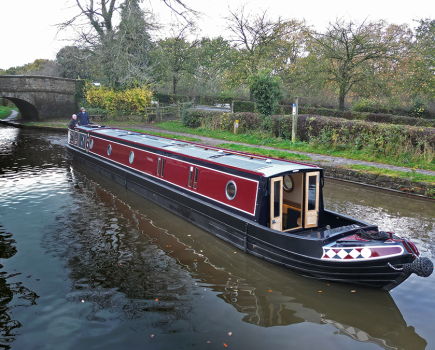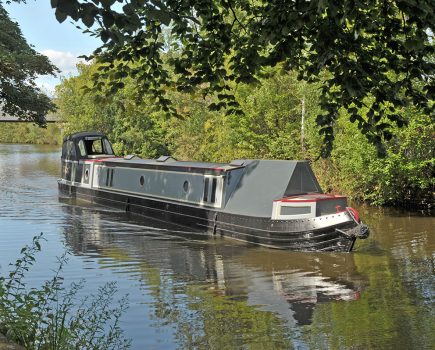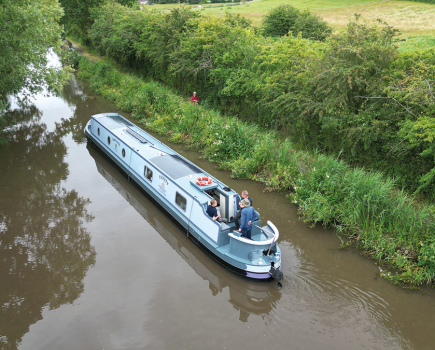Curtis Hudson 60ft
When it comes to narrowboats my responses are purely Pavlovian. Just say the words ‘tug’, ‘recessed panels’, ‘rivets’ and ‘Gardner’ and I’m drooling worse than a dog that’s just discovered the open back door into the butcher’s shop.Well, on this boat, they were just the start – the rhythm section to the virtuoso solo performance that was the extraordinary interior fit-out. Terry Curtis who devised and commissioned Nb Rocket is best placed to explain: “You see all these boats that claim to have a ‘solid oak fit-out’ when what they really have is veneered plywood panels and strips of oak covering the joins. I didn’t want that; I wanted ‘solid oak’ to be just that – solid oak.”So the interior of Terry and Allison’s remarkable boat is built in solid planks of oak – with some solid beech and solid elm thrown in. If that was not enough, pretty much all the interior fittings are solid, handsome pieces sourced from ship’s chandlers or salvaged.It’s very much a one-off but a one-off that should inspire anyone who is either setting out to build up a sailaway or wants to commission a new build that is something special.But why was it in our classifieds? Sadly because after spending four years having it built as something to enjoy in retirement Terry is now too busy in a new business to use it. “We’ve hardly been out on it; we haven’t even had time to get it signwritten. I don’t want it to just sit around: boats are meant to be used.” EXTERIOR
Beautiful. That’s the only word to describe it. Unsignwritten and painted in its handsome yet sober shades of grey and black it may be, out on the water Rocket looks simply stunning. The 60ft shell was built by S M Hudson in its classic josher tug style. The elegant double curves of the planked josher bows lead on past its high tug deck to the gentle sweeping sheer lines of the sides with their row of replica rivets below. It rides beautifully in the water; sitting long and low.Hudsons built their shells in the traditional fashion of old working boats, using a central keelson spine inside the base plate and knees at its junction with the hull sides. The baseplate of Rocket was specified in 15mm rather than the usual 10mm steel while the hull sides are in 6mm and the cabin in 5mm and 4mm steel.The most distinctive feature of the shell is its full length recessed panelling – an expensive extra that is usually confined to the back cabin sides. The roof also features a stop beam across ahead of the engine room while Terry also specified other detail extras usually intended to emphasise the beefy tug nature of his craft. Among them are discrete ‘letterbox’ style vents in the cabin sides from which the necessary low level ventilation is provided via hidden ducts, leaving the doors free of any obtrusive vents.The exterior shows off some of his personal touches too. To bring more daylight into the portholed interior he had built two sets of bubinga wood opening roof lights – writing to the Royal Naval College at Dartmouth to research the exact design. You’ll also spot on the roof two forward facing ‘funnels’ to complement the usual mushroom vents (and there’s a larger one of those too for the back cabin, along with a bulls-eye rooflight).
DESIGN AND FIT-OUT
Hudsons built the boat to a ‘sailaway’ stage and it was then brought down to Terry and Allison’s mooring on the K&A at Bath for fitting out. The woodwork was done by Billy Harris, a skilled narrowboat joiner who came down to Bath in his own boat, moored alongside and spent 18 months on this job! The engineering side of the fit-out was by Ian McDonald who also fabricated the day tank and drip tray in the engine room. The interior is, as we said, in solid European oak, much of it coming from Ireland. The lining is in 18mm thick oak ‘planks’ with substantial oak frames around them. Below the gunwales, the planks change from horizontal to vertical and in the back cabin they’re plain edged rather than beaded in the rest of the boat – a typical bit of attention to detail. Everything is finished in schoolhouse wax to give a soft glow to the timberwork.Throughout the boat there’s a mixture of quarter-sawn oak, revealing its distinctive grain figuring, and plain sawn. There are also hefty and beautifully knotted burr oak ‘shoulders’ while the treads of the front and rear steps are elm salvaged from an old working boat bottom. The floor again is in oak while the ceiling is in cedar forwards of the engine room and oak elsewhere. This is a wood lover’s paradise!It’s all handsomely done but a world away from the intricate machine shop cabinetry of most modern narrowboats. Open cupboard doors and you’ll see the brass screws that hold pieces together; they’re meant to be seen – if Grand Design’s Kevin McCloud was commenting on the joinery he would be using words like “rugged” and “honest” and “tactile”. The boat is laid out in traditional tug style – though even here you won’t be surprised to learn that there are some surprises. Under the eight feet long tug deck is storage shelving and a washing machine, all accessed via sliding doors from the saloon. The saloon and galley are open-plan with each other and then comes a very unusual semi-through bathroom, of which more later.Beyond this is the Gardner 4L2, an ex-fishing boat engine which has been fully restored for the boat, and finally comes a combined bedroom and back cabin that has a lengthways fixed double bed rather than a drop-down boatman’s bed but all the other elements of the back cabin. Except paint – there’s no decorative painting here or anywhere else on the boat’s interior.
SALOONYou step down the chunky elm treads into what is quite a simple saloon with just two armchairs and a free-standing drop-leaf table under the gunwale. Terry and Allison are not tv viewers so there’s no flat screen to be seen but they do like their music and have a very discreet Bose tucked in a corner. This is a zoned system with speakers in the saloon and cabin – the sub-woofer for the saloon is under the stove’s stand – and can play in either or both areas.The stove, a Lockgate oil unit with a back boiler, stands to the starboard side of the steps and as well as heating the room directly pumps hot water to the boat’s two radiators. On the opposite side of the steps are three cupboards on the front bulkhead as well as a base cupboard on which could be stood a dreaded telly.Access to the under-deck area is through sliding doors behind the steps and, cleverly, rather than have to remove these and leave them in the way somewhere, the treads alone can be slid out and stacked in a corner. There’s not a lot of headroom below the deck, of course, so one has to sit down to use the washing machine but there’s bags of storage space along the portside shelves. The calorifier is also located down here.One also starts to spot a few nice finishing touches around the saloon – an elegant wall lamp; a gimbal oil lamp; handsome ceiling light and so on. Many of these were sourced from marine chandlers, Davey & Co who specialise in such elegant fittings. GALLEY
The galley continues the chunky style of the boat, with solid oak cupboards and drawers and solid beech (not beech block) worktops. A second rooflight and hatches on both cabin sides flood the space with light and air.It’s not the biggest of galleys – little more than six feet long – but well organised with plenty of work and storage space. To starboard is the main L-shaped run, centrepiece of which is a ‘mini’ Belfast sink and traditional pillar taps. Under the worktop to its rear is a smallish electric fridge (24v like the rest of the onboard DC electrics) while the rest of the space is taken up with cupboards and drawers. The ‘dead’ corner in the L is a further cupboard whose door is on the saloon side of the unit.Opposite, a large under-gunwale cupboard offers more storage before we reach the impressive looking Taylor’s marine cooker sitting on gimballed mounts. Gimbals? On a canal boat? Well, as many of you know, not all canal and river sides are deep and you can be moored tipped at a bit of an angle on the bottom so it’s not as daft as it may seem.Taylors are the Rolls-Royce of yacht cookers; these days they only make paraffin fuelled versions but Terry acquired one of the last gas fuelled models. It has an oven and grill but only two hob burners.On one side of the cooker are deep drawers while the matching space on the other side is a wine rack – a double depth one that stretched under the gunwales so it can take two bottles, one behind the other, in each section. A wall cupboard on the rear bulkhead either side of the door completes the galley storage.Plenty more nice details here too, including a hanging oil lamp suspended by a chain of brass gas mask clips.
BATHROOM
Go through the doorway from the galley and you see to your left a circular stainless steel washbowl set into an oak cabinet and fed by another pair of restored nickel-silver pillar taps. Opposite this is a door to what looks like a cupboard but open it and there’s a Thetford cassette toilet inside ‘thunderbox’ style woodwork – the front lifting off to release the unit to change the cassette. High above the toilet is a bathroom cabinet.The door itself swings across to close off the doorway into the galley and create a private space (except that there’s no door at the engine room end).The shower is behind another door, which features a stained glass panel made by Allison. It opens to reveal a five-sided shower cabinet – oak lined again – with a large shower head. Switching the light on also starts a fan that draws damp air out via one of those roof funnels.
ENGINE ROOM
The big Gardner 4L2 dominates the engine room. It’s a 1950s unit, acquired in pieces by Terry but found on overhaul to be in generally good order aside from one seized piston. It is teamed up with a modern PRM500 hydraulic gearbox in Rocket.Terry has eschewed a ‘bling’ style rebuild and the engine is painted in a workmanlike light grey with no glittery brasswork add-ons. All the same it’s a smart set-up. On the rear bulkhead there is a large day tank and a hand-pump to fill it from the 158 gallon main fuel tank. Incidentally this has a large, two inch filler and can be filled direct from a tanker so you might be able to haggle a better price for your fill-up. Below this sit a pair of modern engine oil filters, mounted in their own tray so that any oil can be caught and drained when they are changed. A traditional manual bilge pump is also fitted there to empty the engine bilge if need be.Terry has put particular effort into engineering the traditional speedwheel throttle and push-pull gearshift controls for ease of operation and the two are also fitted alongside each other, rather than at opposite sides of the rear hatch, to be less intrusive.Under the floor to one side of the engine are storage spaces for tools and such like while the floor at the other side lifts to access the ten batteries – eight domestics doubled up as four 24v units and two engine start.These are charged by the engine’s single, heavy duty 100 amp Leece-Neville alternator allied to an Adverc battery monitor. The 24v DC circuits feed the boat’s lights and DC sockets fitted throughout.Mains 230v AC is via a 24v 2000w Victron Combi as well as landline option and all the electrics are tidily fitted in corner cupboards at the forward end of the engine room.
CABINA four feet wide bed runs down the port side of the boat, with a line of cupboards above it and a double wardrobe beyond. Below the bed are more cupboards as well as another sub-woofer for the hi-fi. Above the bed head is a delightful little art deco style reading light.A lovely burr oak shoulder divides this area from the classically built boatman’s cabin area at the rear, with its drop-down table, bench seat and various cupboards and drawers. Really special hinges, catches and a lovely light finish it off a treat. From here a coal-box style step – again in salvaged elm – leads out onto the deck.ON THE WATERThe crowded and somewhat shallow Bath end of the K&A did not give much opportunity to try out Rocket on the water so we can only say that it steers accurately and without needing too heavy a hand on the tiller and also that the big engine pushes it along with just the gentle thump of a ticking-over beat. CONCLUSIONFor me, this boat ticks all the boxes. I love tugs –I own one – and I love oak (I’ve lived in a succession of oak framed houses). I guess if I won the lottery I’d be knocking on Terry and Allison’s door with a cheque for the �115,000 that they rightly feel their boat is worth.But I have to concede that it won’t suit everyone. Some, perhaps, will find the all encompassing oak interior rather encroaching and monochrone. And its internal configuration won’t work for all: the cooker is an oddball, the fridge small, the washing machine hard to reach and so on. It’s strictly a two-berth boat, too (though a bed settee would sort that one) and the quirky bathroom layout might not appeal.But all that said, anyone with this sort of money wants a boat that makes a real statement and if their taste matches Terry and Allison’s then those shortcomings will just fade away because it will simply be love at first sight.
LENGTH 60ft BEAM 6ft 10in SHELL S M Hudson Tel: 01827 311317 STYLE Trad tug FIT-OUT Solid oak ENGINE Gardner 4L2 ELECTRICS 75 amp Leece-Neville alternator, 2000w Victron Phoenix Multiplus inverter/charger CHANDLERY Davey & CO Tel: 01206 500945 WINDOWS Procast Tel: 01623 860640 COOKER Blakes-Lavac-Taylors Tel: 01489 580580
Terry & Allison Curtis S M Hudson Glascote Basin Basin Lane Glascote Staffs B77 2AHCURTIS ROCKET �115,000 Tel: 07970 513233







